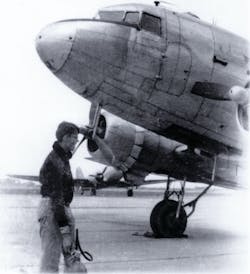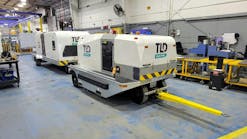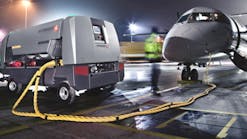Ground equipment has been around since the very first flights. The Wright Brothers only had 12 horsepower to power the early Wright Flyer with so they depended on a catapult system and a track to launch their early flights.
It was powered by a falling weight. I have never seen anything on how they got that weight up the tower. But there it was. They used it for many years before engines grew powerful enough to allow unboosted takeoff.
They had no need for fuel or oil trucks since the amounts of fuel and oil were small by today's standards. Ground power? Well yes, they did use a battery to tickle the ignition to get things going. Pneumatics and air conditioning? Not needed. Access stands? Maybe a ladder or two.
It pretty much stayed that way for some years after. But by the World War I there were fuel trucks and an invaluable aid to starting aircraft – the Hucks starter. It was a truck fitted with an overhead shaft that engaged a dog in the propeller hub.
Aircraft towbars of a crude sort also came about in World War I, but there were no dedicated designs for tow tractors. A truck was good enough and most of the time the airplanes were pushed around by hand.
By the end of the war there were some pretty respectable-sized bomber aircraft. Access stands became a necessity. The big biplane airliners grew out of them. These featured fabric covering which meant you were not going to go walking on the wings.
The engines were also many feet above the ground that stalky stands of sufficient height made of welded tubing came into being. The pleasure of working off a platform stand as compared to an A-frame ladder is indescribable. You have a place to put your tools and equipment and you are not in danger of falling off.
Like everything else, World War II changed everything that came before and after it. Ground equipment and commerical aviation, for that matter, really started to come into its own afterward. You can read more about that is our cover story starting on page ??.
A lot of early commmercial flights were done with seaplane airliners commonly known as flying boats. This aircraft required a whole different set of "ground" support equipment. There was a need for boats, of course, to tow aircraft, in fact just to get out to them when they were on a mooring.
A fuel boat was needed, too, although often they just carried drums and a hurdy-gurdy or a wobble pump for the ground people to pump the fuel up. I knew a Pan Am mechanic who mourned a lot of lost tools now rusting at the bottom of Flushing Bay off the La Guardia's seaplane terminal. They tied strings to them when possible so as not to lose them if dropped.
One other piece of ground equipment that was unique was a big wheeled cradle. At La Guardia Airport, it ran on rails built into the ramp leading from the big hangar to the seaplane ramp and down into the water of Flushing Bay.
The cradle would go down until it was submerged and then the big flying boat was gingerly pulled into it. The cradle and all were pulled from the water and the whole shebang pulled into the hangar for servicing. The rails and ramp were still there in the 1950s.
Back on the ramp there was the problem of handling baggage and passengers. Carts were used for the bags and freight and strong arms and backs humped them into the aircraft. Some aircraft like the Ford Trimotors had baggage bins in the wings, a bottom surface lowering down to reveal a bin for loading. No loader lifters, no belt loaders, just stands and strong arms.
In most cases, loading passengers was easy. You opened a door to the ramp, pointed out the plane visible through the wind and rain, passed out umbrellas and let them go for it. The airplanes were low to the ramp so only a small step stand was needed to get them up. Even the classic DC-3 only required four or five steps.
GPUS TAKE SHAPE
By the 1930s, there grew a need for ground power. 12V DC was initially used. Later 24V DC became the standard. Aircraft engines could be started off the ship's battery, but that left you with a depleted battery at the beginning of the flight. The easiest answer were battery carts, literally big batteries on a wheeled cart to be taken out, the lead plugged into the aircraft and the power supplied for the engine start.
Ideally, the cart was then returned to a ground charger for charging. That, of course, was a weak point. People forgot to put them on charge just like they forget to gas ground equipment. Just when you needed power the most, you'd have a dead battery.
So GPUs became standard ground equipment. The older aircraft, DC-4, DC-6 and 7 and the Connies, were quite tolerant of the quality of the external power. Some had over-voltage cutouts so you couldn't fry the electronics by a power cart gone wild. Others did not. A DC-4 one day was happily lapping up 35 volts with only a pair of boiling batteries to be noted.
Ground power carts came in various flavors. In the hangars, they were usually motor generators. The larger ones were powered by 440V commercial power. Sometimes things went wrong inside them, probably due in this case to some of them being used outside in the wind and rain with a canvas cover to protect them.
One day, a GPU was happily eating 440V AC and pumping out 28V DC into an L-1049 Connie. One of our mechanics picked up a ground wire and clipped it to the ground stake in the ramp and stretched it over to the aircraft. Crouching slightly he bent over to attach it to a ground lug on the nose gear. He reached out to steady himself and touched the aircraft while holding the ground wire and executed a perfect half a back flip from a crouch.
This seemed extraordinary to us as he just lay there. He was unconscious, but breathing. I took the ground wire and tossed a loop of it onto the nose gear. It instantly smoked from all the oil on it and then burst into flames and finally the wire glowed red and burned through.
There was an internal short inside the power cart due to moisture and one leg of the 3 phase 440 was laid on the aircraft. The aircraft didn't notice as it was on the ground side.
The gasoline-powered units were either tow-around or self-propelled. Some were dual use and could be used for light towing. I was in Cleveland one day teaching a course. Naturally, it was snowing and they decided to pull one of our Convair 440s into the huge hangar. I was called to evaluate the damage caused by the aircraft nose striking a column deep in the hangar.
The generator/tow unit was slowly pulling the aircraft in when the worn throttle linkage flipped over-center and the engine surged to the "GENERATE" setting. The driver tried to pull it out of gear, but the gearshift was stuck. While fighting it, he allowed the unit to veer left and the aircraft struck the post. It tore a pretty big hole. You could see the rudder pedals inside.
Meanwhile, the British favored 112V DC for the muscle power and 28V DC for the control. The power unit thereby had two cables.
One dark and stormy night, I was the only one on the ground while a taxi crew started a Bristol Britannia. This meant I had to pull the crew stand, give them signals to start the engines, pull the ground power unit away, pull chocks and then marshal the aircraft out of the parking spot.
After engine start, I pulled the ground power cable and stowed it on the tow-around generator. Note I said cable, not cables. I towed the generator away with the 112V cable still plugged in. It damaged the receptacle on the aircraft. Lesson learned.
With the advent of AC as the prime on aircraft came a need for ground power that required not only voltage control but also frequency control. We found early jets, such as the B707, DC-8 and Electra, were finicky about those two, but didn't care much about the electrical cleanliness of the juice. We could not engage some of the earlier GPUs on later aircraft since there was too much electrical hash that could only be seen on an oscilloscope. The solid state units on board were intolerant of this.
And then there was the muscle for engine starting. No longer electrical (although we are swinging back to that), you needed pneumatic air, and lots of it to spin up the engines. There were many units around. Some were simply aircraft APUs, gas turbines, truck or cart mounted. They worked well, but were voracious consumers of kerosene. Noisy, too, but all pneumatic blow carts are noisy.
For a while there were some units using a Roots Blower powered by a big Ford industrial gasoline engine. These had to crank up to a very high rpm and so were extremely noisy.
Worse yet was the tendency of uncaring rampies to use one to start an aircraft and then shut it down without giving the poor engine a chance to cool down. The exhaust manifolds on those engines were quite visible through a grill and glowed a bright red when pumping air.
You could almost hear the valves distorting inside when shut down at that red hot heat.
DEICING BEGINS
Of course in this season one cannot forget deicing/anti-icing. Deicing was basically all we did back in the 1940s and 1950s. You got the snow off and it was up to the crew to get the plane out and off before the snow built up on the wings. I have written of a terrible fright I got (but only half of what the flight crew got) in deicing a DC-6B.
We deiced the airplane with a 50-50 mix of glycol and water with me manning the hose. The airplane was clean but the snow was pouring down. Off it went and we could hear it, but not see it take off. We were preparing to go back to the hangar to refill the truck when the airline rep came running over.
"He's coming back on an emergency," he said.
We heard him land and eventually the aircraft appeared through the snow. He parked and the cockpit window slid open and the captain yelled down, "You almost killed us you #$%@&% ."
Weeks later, he admitted it wasn't us. He turned on the wing deicer heaters on takeoff. The snow melted, the water ran back to the very cold war cap at the back of the leading edge and built up into a ridge stretching the full span of the wing. A perfect spoiler.
My stomach still contracts when I think of that moment of the captain yelling down at us.
I have always been sensitive about deicing since that day and welcomed the changes that came in equipment and in regulations. Hold times and such were non-existent in my early days.
As usual it took a crash to put an end to the casual way we treated freezing precipitation. Gone are the first rigs I used, a hundred-gallon tank of glycol with an immersion heater, a putt-putt engine and a garden sprayer hose and wand. I deiced Connies and DC-6s that way by walking on the wing with a broom and then spraying it.
The advent of trucks with elevating booms, heated fluid and a mix selector made a world of difference, but it still isn't easy. The fixed deicing stations and the like make it a lot safer for personnel. Driving a truck in a raging snowstorm with the fog and steam from the deicing is always nerve-wracking and has led to a lot of damages. Still, freezing rain, the worst of all weather phenomenon, will bring an airport to its knees as will major snowstorms.
On the other hand, there is nothing to bring joy to an auto shop (I still call the ground equipment shop that) like a lavatory truck.
Even after being dumped, flushed and steam cleaned, the aroma is there.
Having been a freight dog for the last 15 years of my career, I am not up on the latest developments.
But I certainly do remember having to carry the honey bucket off the airplane and pour it into the biffy truck. Many freighter conversions still use a port-potty design. A lot of things go down aircraft toilets, bottles being a favorite. Then, too, I have seen a biffy wagon that would not dump because the valve was clogged. After pumping it out, a nasty job at that, about 50 expanding plugs used on the aircraft toilet drain were found. That, and a selection of plastic soda bottles.
Still, the saddest sight I have seen was a lav truck driver who called for maintenance as a DC-8 wouldn't dump. He said it was plugged and used a broomstick up the open dump hole to show me. He pushed it up hard and punctured the crust of ice that had formed in there and received the full contents of the tank over him. I was fortunately clear. There he stood, excreta all over him and, it being winter, the hood on his parka behind him full to the brim.
Water trucks are a different story – or at least I hope so. Again, what a change from my beginnings. Back then it wasn't a truck, it was a cart. It was filled using a garden hose attached to a water tap. If it started looking a bitty tatty, it was flushed out using a mix of Clorox bleach and water. But that didn't happen with any regularity.
The fill fitting on the hose always seemed to be missing, of course. It was fitted with a wobble pump. It took a lot of effort to fill some types of aircraft where the water tank was in the ceiling of the cabin. By the time of the jets and their much bigger water tanks, trucks with motorized pumps came into use. They still freeze if left outside just like the old water carts.
Finally, fire extinguishers are an oft neglected part of ground support equipment history. In the days of piston-powered aircraft, however, mechanics were very familiar with fire extinguishers. Engine starting, particularly in cold weather, sometimes resulted in rather spectacular fires in the stacks, cowling and often the ground. Raw fuel would accumulate in the stacks and dribble from the blower drain.
A burp from the engine would throw a little fire and there you were. You had to make a judgment call as to if the engine would start and blow out the fire or if it was a little too vigorous for safety. In that case, the CO2 extinguishers of the day came into play.
The good thing was they did no damage and left no residue.
The bad thing was you had to get in close. And there was also a prop to consider, easy to forget when there is fire in front of you. Never forget the prop! One thing for sure, by going from Avgas to Avjet fuel we greatly reduced the fire hazard. With so few fires we have also lost the skills we used to have in fighting them.
I could go on about tugs, lift trucks, loader lifters, belt loaders, passenger loading stairs, Whiting Loadairs, passenger loading bridges, catering vans, maintenance docks in hangars, and, of course, aircraft jacks. They have served me as subjects for many ruminations.
Happy 20th Birthday, Ground Support Worldwide. I hope you will keep me writing for a few more years.
Dedicated to Vinnie Minuto, the first GSE mechanic I met. We both worked at Lockheed in the mid-1950s. We were on graveyard shift and Vinnie was alone in the automotive shop. Aside from responding to our equipment breakdowns, he brewed hot, strong, coffee in the back of his shop that could wake the dead and thaw frozen mechanics.




